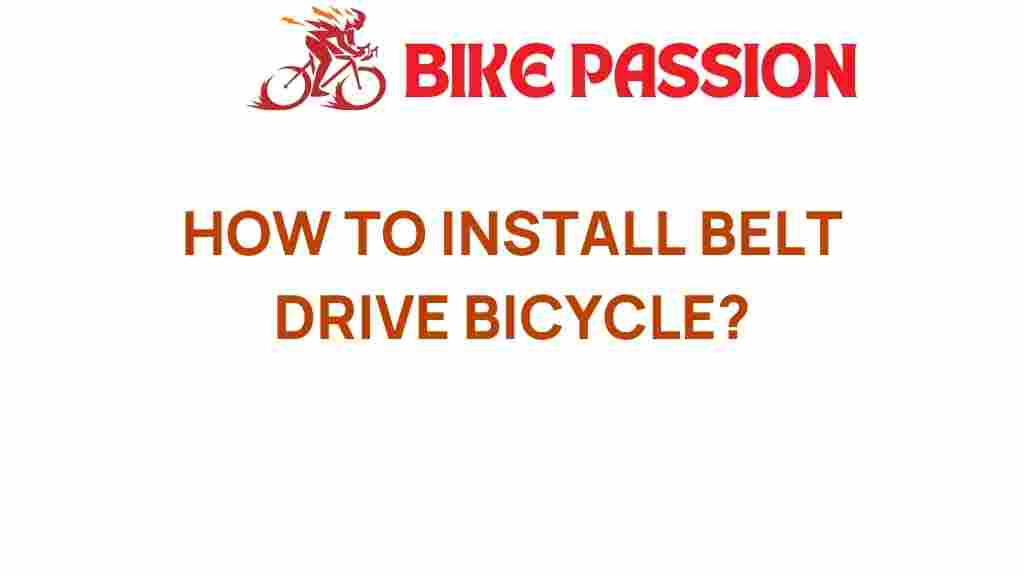Unlocking the Secrets: How to Install a Belt Drive Bicycle
If you’re a cycling enthusiast looking to upgrade your ride, installing a belt drive bicycle can be a game-changer. Belt drive systems offer a cleaner, quieter, and more efficient alternative to traditional chain drives. In this comprehensive installation guide, we will walk you through the steps necessary to install a belt drive system, provide cycling tips, bike maintenance advice, and discuss sustainable cycling practices. Whether you’re a DIY bike repair novice or an experienced mechanic, this guide will equip you with the knowledge to enhance your cycling experience.
Why Choose a Belt Drive Bicycle?
Belt drive bicycles are becoming increasingly popular among cycling enthusiasts for several reasons:
- Low Maintenance: Unlike chains, belts don’t require regular lubrication and are less prone to wear and tear.
- Durability: A high-quality belt can last significantly longer than a traditional chain.
- Cleanliness: Belt systems do not create grease and grime, making your bike cleaner and more enjoyable to ride.
- Sustainability: By reducing the need for replacements and maintenance, you can contribute to more sustainable cycling practices.
Essential Tools for Installation
Before diving into the installation process, it’s important to gather the necessary tools. Here’s a list of what you’ll need:
- Adjustable wrench
- Allen key set
- Torque wrench
- Scissors or a cutting tool
- Measuring tape
- Bike stand (optional but recommended)
- Cleaning supplies
Step-by-Step Installation Guide
Now that you have your tools ready, let’s explore the step-by-step process for installing a belt drive bicycle.
Step 1: Prepare Your Bicycle
Before starting the installation, ensure your bicycle is clean and in good condition. Remove the existing chain if applicable. If you’re converting a traditional bike, you’ll need to remove the rear wheel and derailleur.
Step 2: Install the Belt Drive System Components
The main components of a belt drive system include:
- Belt
- Front and rear sprockets (or pulleys)
- Frame with belt-compatible dropouts
Follow these steps:
- Install the Rear Sprocket: Attach the rear sprocket to the rear hub, ensuring it is securely fastened with the appropriate bolts. Use a torque wrench to tighten to the manufacturer’s specifications.
- Install the Front Sprocket: Depending on your bike’s design, the front sprocket may attach to the crankset. Ensure it is aligned properly.
- Attach the Belt: Loop the belt around the rear and front sprockets. Ensure the belt is taut but not overly tight. Adjust the position of the rear wheel if necessary.
Step 3: Adjusting the Tension
Proper tension is crucial for the performance of your belt drive bicycle. Here’s how to adjust it:
- Check the manufacturer’s recommended tension specifications.
- Adjust the rear wheel position to achieve the correct tension.
- Recheck the tension after securing the wheel.
Step 4: Final Checks
Before you hit the road, perform the following checks:
- Ensure all bolts are tightened to the correct torque.
- Verify that the belt is aligned properly and runs smoothly without rubbing against the frame.
- Check the overall functionality of the bike, including brakes and gears.
Troubleshooting Common Issues
Even with careful installation, you might encounter some common issues. Here are solutions to potential problems:
- Belt Slipping: If the belt slips, check the tension and adjust it as necessary. Ensure that the sprockets are not worn or damaged.
- Noisy Operation: A noisy belt can indicate misalignment. Double-check the belt’s position and sprocket alignment.
- Wear and Tear: Regularly inspect the belt for signs of wear. Replace the belt if you notice any cracks or frays.
Bike Maintenance Tips for Belt Drive Bicycles
Maintaining a belt drive bicycle involves less work than a traditional chain bike, but you still need to follow some guidelines:
- Regular Inspections: Check the belt and sprockets periodically for signs of wear.
- Cleaning: Wipe down the belt and sprockets with a clean, dry cloth to remove debris.
- Keep it Tight: Ensure that the belt tension remains within the recommended specifications.
Cycling Tips for Enthusiasts
As you enjoy your new belt drive bicycle, keep these cycling tips in mind:
- Stay Hydrated: Always carry water, especially on longer rides.
- Plan Your Route: Use maps or apps to find bike-friendly paths.
- Ride Responsibly: Follow traffic rules and be aware of your surroundings.
- Join a Community: Connect with other cycling enthusiasts to share tips and experiences.
Sustainable Cycling Practices
Switching to a belt drive bicycle is one step towards more sustainable cycling. Here are additional practices to consider:
- Choose Eco-Friendly Products: Use sustainable bike accessories and gear.
- Reduce Carbon Footprint: Opt for biking over driving whenever possible.
- Support Local Shops: Purchase from local bike shops to support your community.
Conclusion
Installing a belt drive bicycle can enhance your cycling experience by providing a low-maintenance, durable, and environmentally friendly option. By following this installation guide, you can confidently convert your bike or build a new one from scratch. Remember to perform regular maintenance to keep your belt system running smoothly and efficiently. Embrace the joy of cycling with your new setup and consider sharing your journey with fellow cycling enthusiasts. For more insights on bike maintenance and cycling tips, check out this helpful resource.
With the shift towards sustainable cycling, every pedaled mile contributes to a healthier planet. Happy cycling!
This article is in the category Maintenance and created by BikePassion Team
